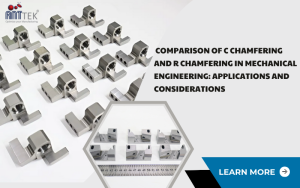Heat treatment 45-50 HRC in precision mechanical processing
Heat treatment is a crucial metallurgy process that enhances metal components’ mechanical properties. One specific aspect of heat treatment is achieving a hardness level between 45 and 50 HRC (Rockwell Hardness C scale). This range is often desirable for various applications, such as producing cutting tools, gears, and bearings. In this article, we will explore the fundamentals of heat treatment and the techniques employed to attain the desired hardness of 45-50 HRC.
What is heat treatment?
Heat treatment is a controlled process involving the heating and cooling of metals to alter their physical and mechanical properties. The primary objectives of heat treatment include improving hardness, strength, toughness, and machinability, as well as relieving internal stresses. The process is typically applied to steel and other ferrous alloys, although non-ferrous metals can also undergo heat treatment.
Key Stages of Heat Treatment
Annealing
The process begins with annealing, where the metal is heated to a specific temperature and then slowly cooled. This relieves internal stresses and refines the grain structure, preparing the metal for subsequent hardening processes.
Hardening
The critical step for achieving 45-50 HRC hardness is hardening. The metal is heated to a temperature above its critical transformation point and then rapidly quenched in a quenching medium such as oil or water. This rapid cooling “freezes” the crystalline structure, resulting in increased hardness.
Tempering
While achieving high hardness is essential, it often comes at the expense of brittleness. Tempering is the process of reheating the hardened metal to a specific temperature, followed by controlled cooling. This imparts toughness to the material while maintaining a significant level of hardness.
Factors Influencing the Outcome
Several factors play a crucial role in determining the success of achieving 45-50 HRC hardness through heat treatment:
Alloy Composition
Different metals and alloys respond differently to heat treatment. The composition of the material must be considered to ensure the desired outcome.
Heating and Cooling Rates
The rates at which the metal is heated and cooled significantly influence the final hardness. Controlled rates are essential to avoid issues such as cracking or insufficient hardening.
Quenching Medium
The choice of quenching medium, whether oil, water, or air, affects the cooling rate and, consequently, the hardness achieved. The selection of the quenching medium is a critical decision that depends on the specific material and the desired balance between hardness and toughness.
Tempering Temperature and Time
Tempering is a delicate process that involves reheating the metal to a specific temperature. The tempering temperature and duration are carefully chosen to achieve the desired hardness and toughness. The tempering process must be precisely controlled to avoid over-tempering or under-tempering.
Pre- and Post-Heat Treatment Processes
Pre-heat treatment processes, such as machining or surface preparation, can impact the effectiveness of heat treatment. Additionally, post-heat treatment processes may be employed to further enhance specific properties or meet certain requirements.
Applications of heat treatment 45-50 HRC
Metals and alloys with a hardness in the 45-50 HRC range find applications in various industries, including:
Tool Manufacturing
Cutting tools, drills, and milling cutters require a balance between hardness and toughness to withstand wear and abrasion. Heat-treated materials in the 45-50 HRC range are well-suited for these applications.
Bearings and Gears
Components in machinery, such as bearings and gears, benefit from the enhanced durability provided by heat treatment. The 45-50 HRC hardness range ensures optimal performance and longevity.
Automotive Components
Critical automotive components, like crankshafts, camshafts, and gears, often undergo heat treatment to achieve the necessary hardness for withstanding the demanding conditions of internal combustion engines.
Aerospace Industry
Aircraft components, particularly those in engines and landing gear systems, require materials with a precise balance of hardness and toughness. Heat treatment in the 45-50 HRC range ensures these components meet stringent performance standards.
The heat treatment process is a meticulous and crucial step in the metallurgical industry, allowing manufacturers to tailor the properties of metals to specific applications. Achieving a hardness of 45-50 HRC requires a deep understanding of the material, precise control of temperature and cooling rates, and careful consideration of the quenching medium. The resulting materials are prized for their durability and versatility, finding applications in a wide array of industries where hardness and toughness are paramount. As technology advances, the science of heat treatment continues to evolve, pushing the boundaries of what can be achieved in the pursuit of optimal material performance.

















